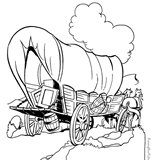
The Oregon Trail - South Alternate

During the mid-nineteenth century, an estimated 200,000 emigrants traveled on
what we now call the Oregon Trail in southwestern Idaho.
By the time they reached Glenns Ferry Idaho,
emigrants had traveled more than a thousand miles.
In 1843, Overton Johnson and William H. Winter followed a
spur off the main trail that bypassed the dangerous Three Island Crossing near
Glenns Ferry. The South Alternate
of the Oregon Trail (also called
the Snake River Cutoff) bypassed two dangerous river crossings by following the
south side of the Snake River. Between 10,000 and 20,000 emigrants used the
South Alternate route in the decades that followed.
The trail was rougher, and there was less grass and water than on the
north side. The South Alternate
rejoined the main trail 5 miles west of present-day Nyssa, Oregon.
Most emigrants passed through Owyhee County in August.
Emigrants hugged the Snake River where they could.
Today's Idaho State Route 78 roughly follows the path of the South
Alternate route of the Oregon Trail.
However, remnant ruts of the original trail can be found in many parts of
Owyhee County.
Emigrants often camped along Castle Creek, the site of the Utter Massacre, one
of the worst massacres that ever occurred on the Oregon Trail. Seventeen
emigrants
were killed near Castle Butte in September 1860. Many escaped to hide in the
brush along the Snake River. Their ordeal continued for many weeks until the few
remaining survivors were rescued on the Owyhee River, starving and near death.
The trek along the South Alternate Route required occasional steep descents and
ascents with the animals down into the Snake River canyon to get water.
The climb up Sinker Creek Grade in Owyhee County was one of the steepest along
the Oregon Trail. It required
emigrants to double team their wagons.
Ruts in the sandstone on top of the bluff are carved a foot deep.
From Sinker Creek, the Oregon Trail emigrants crossed Murphy Flat and then
descended into Striker Basin, just north of Murphy.
The main trail followed Rabbit Creek north to the base of Guffey Butte.
In later years, emigrants used a northern spur, probably to avoid
sections of Rabbit Creek that had been washed out by floods.
One of the emigrants that traveled the South Alternate trail was Abigail Scott
Duniway, an American women's rights advocate, newspaper editor and writer, whose
efforts were instrumental in gaining voting rights for women. At the age of 18,
she emigrated from Illinois to Oregon with her family in a party of 30 with 5
ox-drawn wagons. Their trek was 2,400 miles.